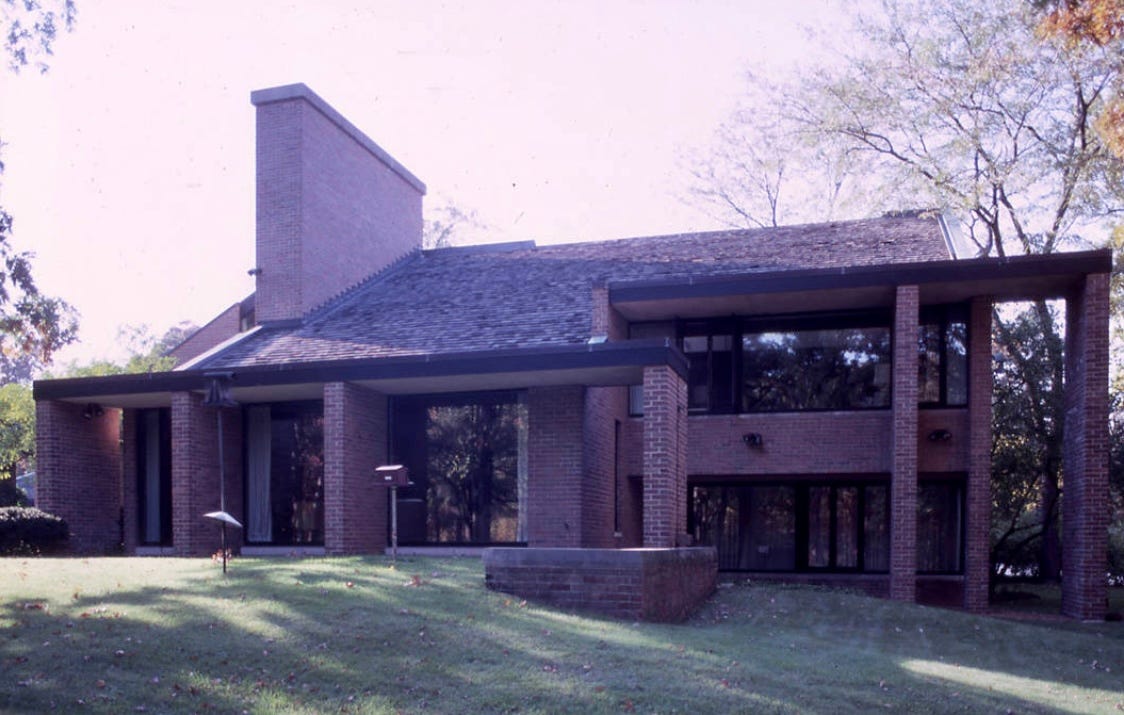Edward Dart's Florsheim House

This piece is about a house currently for sale designed by Edward Dart, an architect I will be writing about on a monthly basis as we remember him on the 100th anniversary of his birth. At the end of January I wrote about Dart’s now-demolished Emmanuel Presbyterian Church in Pilsen, this month I turn to a modernist residence in Lake Forest that Dart designed for a well-known local family in 1964.

The residence was built for camera manufacturer Leonard S. Florsheim Jr. His father had founded the Chicago Motor Coach Company, a private bus fleet later purchased by the Chicago Transit Authority, along with John D. Hertz who is best known for Hertz Rent-A-Car. Leonard Jr.’s brother was the modern artist Richard Florsheim. Although Leonard did not get to enjoy his home for too long as he passed away just thirteen years after its construction, the family continued to own it until the property hit the market for the first time ever in July of 2021. Now eight months later the home has finally been listed as contingent, meaning an offer has been made.
Leonard’s wife Nancy Rothschild, who died in 2014, was the great-granddaughter of Nelson Morris, a German-Jewish immigrant who got his start with John B. Sherman after his arrival to Chicago in 1854. Five years later he became the founder of Nelson Morris & Co., which became one of Chicago's largest meat packing companies. It was a large supplier to the Union Army in the Civil War and became one of America's leading food companies with operations throughout the country. Before it merged with Armour & Co. in 1923, the Morris Company had reached annual sales of $100 million.

The Florsheim name is most associated with the shoe company that had been founded in Chicago by a different branch of the family, Leonard Sr.’s cousin Milton back in 1892. The business grew into one of the largest shoe manufacturers in the world, but slowly declined after the family sold it in 1952. These were the Florsheims, specifically Milton’s son Harold and his wife Sarabel, who lived nearby to Leonard and Nancy and later donated what would total nearly 75 acres of the Florsheim Nature Preserve to Lincolnshire. The preserve abuts the 17 acres that once belonged to Leonard Florsheim Jr., which not only included his own 7000 sq ft home but a pool and pool house, three-bedroom caretaker’s cottage, barn, outbuildings, paddocks, and a pond.

The one element that sets the architect Edward Dart’s buildings from others was his use of Chicago common brick, whether it was at St. Procopius Abbey in Lisle or this distinctive modern masterpiece in Lake Forest. Dart liked to say that using local brick “gives the houses a touch of humanity.” The flat roofed brick design reminds me a lot of his Richard Henrich House, which was built around the same time.
Dart always tried to integrate his buildings with the surrounding landscape. Large expanses of glass take in the views of the wooded property, blending the brick-filled interior with nature. Occupants feel a connection with the outside world whether it’s views of the atrium garden or the clerestory windows letting in light from the sky. Dart’s integration of natural light into a space was one of his trademarks. Not only did it wash the walls and brighten up rooms but different patterns and textures were created throughout the day as the light changed. This is one of the reasons why Dart doesn’t fall so easily into the “moderism” label; you can see how his architecture has links to Organic Architecture as well as the Midwest Prairie School.

Considering the same family owned the property for nearly sixty years, it’s not surprising to see all the original details survive inside the home from the glazed brick floors to wood-beam ceiling. There are so many impressive details through the space like built-in cabinetry and furniture, a custom-designed arched wooden front door, a Dart-designed chandelier in the dining room, enormous brick hearth, and even a cool vintage element with the full wet-bar hidden inside a closet. Dart’s simplified design still feels modern and fresh even in this “everything grey and white” world we live in today. In my personal opinion, it feels timeless. This modernist residence will still look good a hundred years from now.

If it wasn’t for the home’s location right next to busy I-94 as well as the hefty price tag of almost $3.5 million, I would have seriously considered buying this property. I mean, look at it! :) But in all seriousness, I hope this property has found the right owner who will preserve Dart’s legacy, unlike the Barry Crown House in Glencoe (1963) that was torn down in 2018. We need more people like Maria Ponce Berre & Trey Barre and Ann Oleinik & Kamran Foruhar, two young couples who have both recently purchased Dart-designed homes in Barrington Hills. Instead of demolishing the dwellings, they are respecting Dart’s work by saving the homes, even sharing them on Instagram (henrichouse and ann.oleinik).




